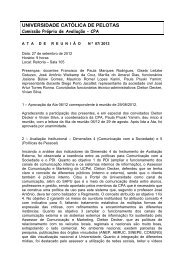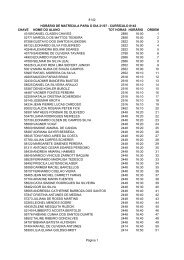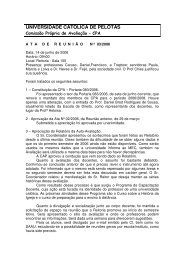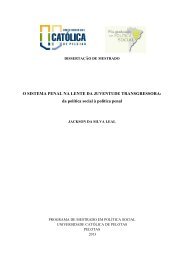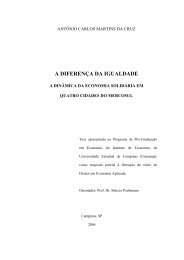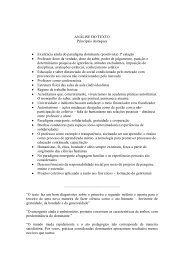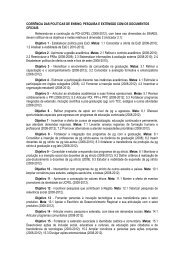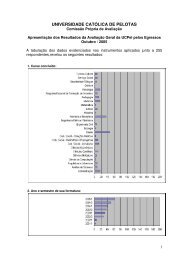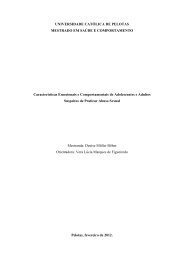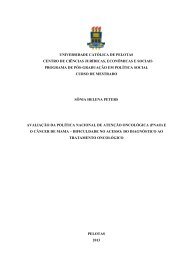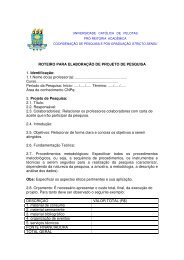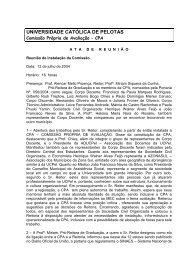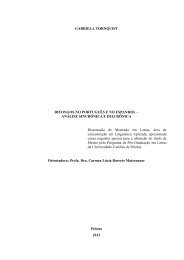Karen Amaral Tavares Pinheiro - Universidade Católica de Pelotas
Karen Amaral Tavares Pinheiro - Universidade Católica de Pelotas
Karen Amaral Tavares Pinheiro - Universidade Católica de Pelotas
Create successful ePaper yourself
Turn your PDF publications into a flip-book with our unique Google optimized e-Paper software.
126<br />
Statistical Package, version 9. Descriptive statistics were used to report the socio<strong>de</strong>mographic<br />
information. Clinical characteristics of the sample used to assess infant<br />
neurobiological - motor <strong>de</strong>velopment (i.e., the AIMS Score) were analyzed using one-way<br />
ANOVA. Bonferroni correction and correlations within the AIMS scores and biological<br />
markers was analyzed using a Spearman correlation. The Spearman correlation was used<br />
because the distribution of biomarkers does not fill the requirements of kurtosis and skewness<br />
to normal variables. The variables inclu<strong>de</strong>d in bivariate analyses were as follows: in the first<br />
level, social class, maternal age, type of <strong>de</strong>livery, infant sex, prematurity, birth weight,<br />
smoking, alcohol consumed in last year; in the second level, history of affective disor<strong>de</strong>rs,<br />
postpartum affective disor<strong>de</strong>r (PPAD), type of PPAD episo<strong>de</strong>, mother anxiety disor<strong>de</strong>r,<br />
mother BDNF level, mother NGF level, IL-6 level, mother and infant cortisol levels. Linear<br />
regression of infant neurobiological - motor <strong>de</strong>velopment (i.e., the AIMS Score) was used for<br />
all variables with a p-value ≤ 0.2 when associated with exposition and outcome. We<br />
consi<strong>de</strong>red associations with a p-value ≤ 0.05 to be statistically significant. Furthermore, to<br />
<strong>de</strong>termine the grouping of the associated factors with infant motor <strong>de</strong>velopment, we<br />
conducted an exploratory factorial analysis. The extraction method was Primary Component<br />
Analysis (PCA). The varimax rotation was used to facilitate the data interpretation, retaining<br />
in<strong>de</strong>pen<strong>de</strong>nce of the factors. Only the variables that had statistical significance in the<br />
regression analysis were inclu<strong>de</strong>d. Factorial loadings greater than or equal to 0.3 were used to<br />
establish the factor to which each variable adhered. The Kaiser-Meyer-Olkin (KMO) test was<br />
conducted to verify sample a<strong>de</strong>quacy in relation to the factorial analysis of primary<br />
components, which was a<strong>de</strong>quate when greater than or equal to 0.5. In the same direction,<br />
Bartlett’s test of sphericity was performed and was consi<strong>de</strong>red significant when less than 0.05.<br />
Finally, to obtain a fuller comprehension of the results, we performed another linear<br />
regression analysis with the generated factor scores in PCA.




